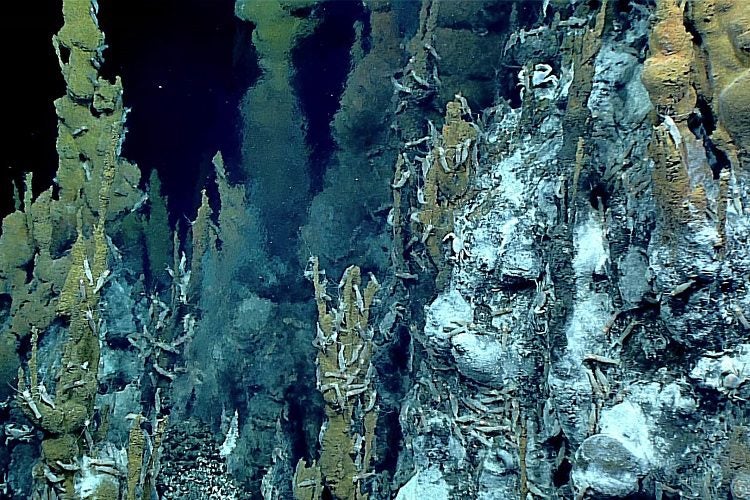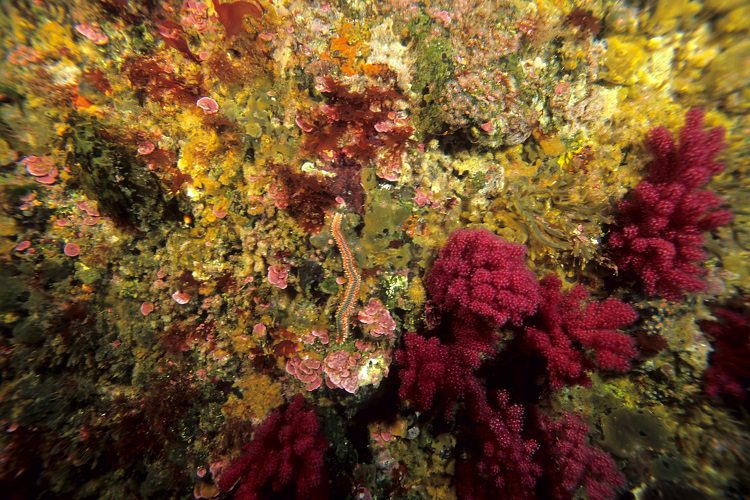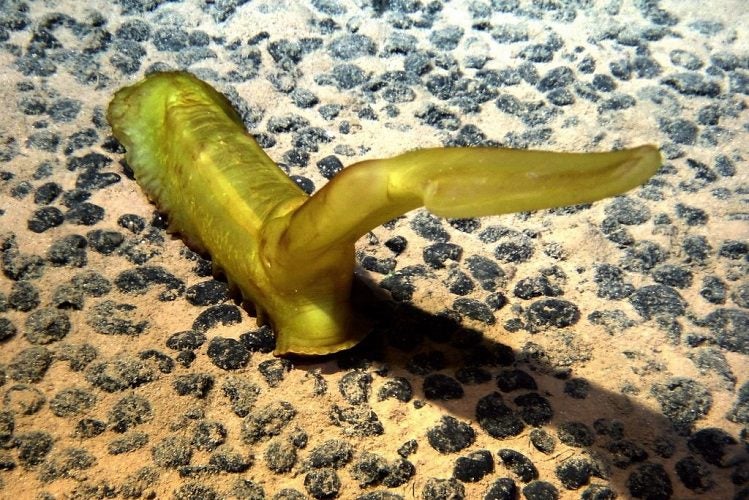DEEP-SEA MINING
Deep-sea mining is a nascent industry focused on collecting minerals from the deep seafloor below 1,000 meters. Proponents argue that such mining could help supply minerals critical to the transition from fossil fuels to cleaner technologies while being a more environmentally friendly alternative to terrestrial exploitation. But this highly disruptive industrial activity in such a remote, fragile, and little-studied system is not without its own risks, which are still poorly understood.
Regulations for mining in areas beyond national jurisdiction – the high seas – do not yet exist. Barring a robust framework for protection paired with strict monitoring and enforcement, deep-sea mining will surely result in irreparable damage to ecosystems that are almost entirely unexplored. For these reasons:
- Oceana supports a complete ban on deep-sea mining at hydrothermal vents and cobalt-rich crusts. Damage to these spatially small and intensely biodiverse habitats is essentially unmitigable.
- Oceana supports a moratorium on all deep-sea mining for polymetallic nodules until comprehensive regulations guided by the precautionary principle 1 and based on the best available science are in place.
Moreover, governments and companies using such metals should prioritize reducing demand for virgin supply (with enhanced recycling, for example) rather than expanding supply.
WHAT IS DEEP-SEA MINING?
Deep-sea mining refers to three distinct, but related, industries defined by the types of ore targeted for exploitation: hydrothermal vents’ massive sulfides, the cobalt-rich crusts of seamounts, and polymetallic nodules found on abyssal plains. These metals are commonly used in electric vehicle batteries and other technologies.
Seafloor massive sulfides are small, discrete, ore-bearing structures produced by hydrothermal venting. Their deposits are rich in gold, nickel, copper, and other metals. Hydrothermal vents host the iconic ecosystems whose discovery fundamentally altered our understanding of what it means to be a living organism on Earth – that life forms and entire ecosystems can exist in the absence of sunlight (Thaler and Amon, 2019). Even inactive vents host unique communities that are wholly distinct from the surrounding seafloor (Erickson et al., 2009).
Cobalt-rich ferromanganese crusts accrete on the surfaces of seamounts, forming the substrate to which habitat-building marine life adheres. These crusts are also enriched in other metals and rare-earth elements (Schlalcher et al., 2014). These underwater mountains are home to colonies of corals and sponges; they support an abundant food web and provide critical habitat for fish and marine mammals and more.
Mining these substrates is, in effect, a comprehensive removal of the ecosystem associated with each deposit. Seafloor production tools grind down the ore body, reducing the deposit to a slurry of sediment and small nodules which can be pumped to the surface via a riser and lift system for later processing on land (Van Dover, 2014; ). Because the ore body is the habitat, all proposed methods for mining these deposits also destroy the overlying ecosystem.
Polymetallic nodules, or manganese nodules, in comparison, are distributed across the abyssal plain, an immense flat part of the deep seafloor that covers 50% of the earth’s surface. These nodules are formed as minerals in seawater precipitate out onto hard objects that have settled on the deep seafloor (the base is usually a small structure like the shell of a single-celled algae but can be objects as large as shark teeth). Nodules rest on the surface of the sediment in vast fields that can, at their densest, resemble a cobblestone path (Jones et al., 2021). Endemic animals, like sponges, worms, and even corals, settle and grow on the nodules themselves, while the sediment underneath and the surrounding waters host similar life to the rest of the abyssal plain, including sea stars, sea cucumbers, and fish (Amon et al., 2016).
Mining polymetallic nodules involves a tank-like benthic crawler which travels across acres of abyssal plain, collecting nodules in large swaths while disturbing the first several inches of seafloor (Paulikas et al., 2020). Nodules are then pumped, whole, to a surface vessel via a riser and lift system where they are prepared for downstream processing. Because the nodules are distributed across a much larger area than either vents or crusts and are more tightly associated with background abyssal benthic communities, more selective mining processes may eventually be possible.
For all forms of deep-sea mining, ore processing occurs on land, using conventional methods, with all of the subsequent environmental impacts associated with industrial metal refining.
IMPACTS OF DEEP-SEA MINING
The environmental impacts of deep-sea mining remain poorly understood and vary significantly depending on the ore being mined, but fall generally into the following five categories:
Destruction of the Immediate Ecosystem
For the life that grows on and around deep-sea mining prospects, destruction will be comprehensive. On both hydrothermal vents and cobalt-rich crusts, the ore is the habitat (Miller et al. 2018). There is no way to mine the ore without killing the marine life attached to it. Polymetallic nodule mining will also be comprehensively destructive to any organisms that live directly on the nodules or in the surrounding sediment (Hein et al. 2020), though because nodules occur across vast swaths of the abyssal plain, the overall impact to this deep-sea ecosystem may be less severe than the mining of vents and crusts (Niner et al. 2018). Moreover, by removing complex structures and creating vehicle tracks and trenches, deep-sea mining changes the structure and topography of these ecosystems – which affects deep-water currents that are essential for dispersal and migration of many species (Gausepohl et al. 2020; Girard et al. 2020).
Sediment Plumes
Activity from deep-sea mining will produce sediment plumes at the mining site as well as in the water column from discharge as the ore is dewatered aboard a surface ship (Spearman et al. 2020). The mining plume has the potential to smother the organisms around the mining site and to spread from the immediate area out several kilometers. The deep sea ordinarily has slow-moving currents and naturally still, clear water so its organisms have evolved without the need or ability to “cough” up or clear sediment from their gills and feeding appendages. This cloud of dust can cause large scale disruption of seafloor ecosystems (Van Dover et al. 2017). The mid-water discharge plume can extend from tens to thousands of kilometers, altering the natural chemical balance of the midwater and disrupting ecosystem function (Drazen et al. 2020).
Noise
Deep-sea mining is noisy. Collector vehicles crawl across the seafloor, bringing light and vibration as well. Riser and lift systems pump a slurry of ore to the surface. Vessels sit “on station” for months. The natural deep abyssal soundscape is consistent and quiet (Chen et al. 2021), but the noise within 6 kilometers (3.7 miles) of a mining site could exceed 120 decibels, the U.S. National Marine Fisheries Service threshold for behavioral impacts to marine mammals (Williams et al. 2022). Noise produced by the riser and lift system as well as the surface vessel can have unpredictable impacts on mid-water and pelagic communities. This noise can cause stress, interfere with communication and feeding, and cause emigration of marine animals, destabilizing ecosystems (Drazen et al. 2020).
Toxicity
The ores contain metals that are not harmful in their typical state but can become more toxic during the mineral extraction process. New research also shows polymetallic nodules are highly radioactive – containing radiation concentrations as much as 1,000 times above what’s considered safe (Volz et al. 2023). Nodule processing would crush them up and could release a fraction of these particles into the air and could be breathed in during the operation. Once the slurry is discharged back into the ocean, the radioactive and toxic metals could poison the immediate surroundings or even spread through currents to adjacent ecosystems and up the food chain through bioaccumulation (Hauton et al., 2017).
Spatial Conflict
Though often out of public view, deep-sea mining poses several potential resource conflicts. Cobalt-rich crusts occur on seamounts which also act as nursery grounds and aggregation sites for commercially important fish species, placing deep-sea mining in direct competition with commercial fishing (van der Grient and Drazen, 2021. Other issues include overlap with subsea telecommunications cables, as well as cultural conflicts (Turner et al. 2019), such as co-occurrence with traditional Polynesian and Melanesian voyaging routes and the Middle Passage, a maritime graveyard for over 2 million men, women, and children kidnapped from Africa and drowned during the Atlantic slave trade (Turner et al. 2020).
WHO IS RESPONSIBLE FOR REGULATING DEEP-SEA MINING?
While coastal states have jurisdiction and exclusive rights over seabed resources within their exclusive economic zone (EEZ) (UNCLOS, 1982; ISA, 2019), the United Nations established the International Seabed Authority (ISA) to regulate mining on the high seas (UNCLOS, 1994). The ISA is currently drafting the “Mining Code” (or “the Code”), a comprehensive set of rules to regulate prospecting, exploration, and exploitation. Though it was originally slated for completion by July 2020, the Code has yet to be finished.
In June 2021, the island nation of Nauru notified the ISA of deep-sea mining plans to be carried out by Nauru Ocean Resources Inc. (NORI), a subsidiary of The Metals Company. The Metals Company, a Canada-based firm, is seeking to become the first to commercially mine polymetallic nodules in international waters. The proposed activity would take place in the Clarion-Clipperton Zone (CCZ) in the North Pacific Ocean between Hawaii and Mexico.
Nauru’s notification triggered the “two-year rule,” which stipulates that the ISA has two years to finalize mining regulations after a sponsor state has notified the ISA that a contractor plans to apply for the approval of a plan to begin mining. The two-year deadline passed in July 2023, but ISA member states agreed that commercial mining should not move forward in the absence of rules, regulations, and procedures relating to mineral exploitation (Tsioumanis, Asterios et al. 2025).
At the ISA’s most recent meeting in March 2025, member states continued work on the draft mining regulations but did not reach agreement on how to consider mining applications submitted before the Code is finalized or the timeline for completion (Tsioumanis, Asterios et al. 2025).
That same week, The Metals Company announced that its U.S. subsidiary plans to apply for a mining permit under U.S. law, outside the ISA process (The Metals Company, 2025). The government of Nauru also reiterated its intention to submit a separate application to the ISA in June 2025 on behalf of NORI (Tsioumanis et al., 2025).
Deep-sea mining is unique in that it is the first global industry for which binding multilateral regulations are being developed prior to commercialization, presenting a rare opportunity to more fully understand and manage the potential environmental impacts before the first ton of ore leaves the seafloor. If done well, a robust regulatory framework informed by the best available scientific knowledge and guided by the precautionary principle might minimize harm to marine life. Oceana is calling for a moratorium on abyssal plain mining until such a framework is in place.
1 The four elements of the precautionary principle are 1) under uncertainty, taking preventive action, 2) activity proponents assuming the burden of proof, 3) exploring alternatives to potentially harmful activities, and 4) integrating public participation into decision making (Kriebel et al. 2001).
MEDIA CONTACT
Gillian Spolarich – gspolarich@oceana.org
SOURCES
Amon, et al. 2016. Insights into the abundance and diversity of abyssal megafauna in a polymetallic-nodule region in the eastern Clarion-Clipperton Zone. Sci Rep 6, 30492. https://doi.org/10.1038/srep30492
Chen, et al. 2021. Baseline soundscapes of deep-sea habitats reveal heterogeneity among ecosystems and sensitivity to anthropogenic impacts. Limnology and Oceanography 66, 3714–3727. https://doi.org/10.1002/lno.11911
Drazen, et al. 2020a. Midwater ecosystems must be considered when evaluating environmental risks of deep-sea mining. Proceedings of the National Academy of Sciences 117, 17455–17460. https://doi.org/10.1073/pnas.2011914117
Erickson et al. 2009. Evidence for a chemoautotrophically based food web at inactive hydrothermal vents (Manus Basin). Deep Sea Research Part II: Topical Studies in Oceanography 56, 1577–1585. https://doi.org/10.1016/j.dsr2.2009.05.002
Hauton et al., C. 2017. Identifying Toxic Impacts of Metals Potentially Released during Deep-Sea Mining—A Synthesis of the Challenges to Quantifying Risk. Frontiers in Marine Science. https://www.frontiersin.org/articles/10.3389/fmars.2017.00368/full
Gausepohl, et al. 2020. Scars in the abyss: reconstructing sequence, location and temporal change of the 78 plough tracks of the 1989 DISCOL deep-sea disturbance experiment in the Peru Basin. Biogeosciences 17, 1463–1493. https://doi.org/10.5194/bg-17-1463-2020
Girard, et al. 2020. Currents and topography drive assemblage distribution on an active hydrothermal edifice. Progress in Oceanography 187, 102397. https://doi.org/10.1016/j.pocean.2020.102397
Hein, et al. 2020. Deep-ocean polymetallic nodules as a resource for critical materials. Nat Rev Earth Environ 1, 158–169. https://doi.org/10.1038/s43017-020-0027-0
ISA. 2019. National Legislation Database. Retrieved from International Seabed Authority: https://www.isa.org.jm/national-legislation-database
Jones, et al. 2021. Environment, ecology, and potential effectiveness of an area protected from deep-sea mining (Clarion Clipperton Zone, abyssal Pacific). Progress in Oceanography 197, 102653. https://doi.org/10.1016/j.pocean.2021.102653
Kriebel, et al. 2001. The precautionary principle in environmental science. Environmental Health Perspectives 109(9):871-876. https://ehp.niehs.nih.gov/doi/10.1289/ehp.01109871
Miller, et al. 2018. An Overview of Seabed Mining Including the Current State of Development, Environmental Impacts, and Knowledge Gaps. Frontiers in Marine Science 4. https://www.frontiersin.org/articles/10.3389/fmars.2017.00418/full
Montserrat, et al. 2019. Deep-sea mining on the Rio Grande Rise (Southwestern Atlantic): A review on environmental baseline, ecosystem services and potential impacts. Deep Sea Research Part I: Oceanographic Research Papers 145, 31–58. https://doi.org/10.1016/j.dsr.2018.12.007
Niner, et al. 2018. Deep-Sea Mining With No Net Loss of Biodiversity—An Impossible Aim. Frontiers in Marine Science 5. https://www.frontiersin.org/articles/10.3389/fmars.2018.00053
Paulikas, et al. 2020. Life cycle climate change impacts of producing battery metals from land ores versus deep-sea polymetallic nodules. Journal of Cleaner Production 275, 123822. https://doi.org/10.1016/j.jclepro.2020.123822
Schlacher, et al. 2014. Seamount benthos in a cobalt-rich crust region of the central Pacific: conservation challenges for future seabed mining. Diversity and Distributions 20, 491–502. https://doi.org/10.1111/ddi.12142
Spearman, et al. 2020. Measurement and modelling of deep sea sediment plumes and implications for deep sea mining. Sci Rep 10, 5075. https://doi.org/10.1038/s41598-020-61837-y
Thaler and Amon. 2019. 262 Voyages Beneath the Sea: a global assessment of macro- and megafaunal biodiversity and research effort at deep-sea hydrothermal vents. PeerJ 7, e7397. https://doi.org/10.7717/peerj.7397
The Metals Company, 2025. The Metals Company to Apply for Permits under Existing U.S. Mining Code for Deep-Sea Minerals in the High Seas in Second Quarter of 2025. https://investors.metals.co/news-releases/news-release-details/metals-company-apply-permits-under-existing-us-mining-code-deep
Tsioumanis, Asterios et al. 2025: Summary report, 17–28 March 2025. https://enb.iisd.org/international-seabed-authority-isa-council-30-1-summary#brief-analysis-meeting
Turner, et al. 2019. Deep-sea hydrothermal vent ecosystem principles: Identification of ecosystem processes, services and communication of value. Marine Policy. https://doi.org/10.1016/j.marpol.2019.01.003
Turner, et al. 2020. Memorializing the Middle Passage on the Atlantic seabed in Areas Beyond National Jurisdiction. Marine Policy 122. https://www.oceandecadeheritage.org/wp-content/uploads/2021/02/Turner-et-al-2020.pdf
UNCLOS. 1982. UNCLOS (1982), Part XI – The Area and UNCLOS Agreement Relating to the Implementation of Part XI of the Convention (1982. Retrieved from https://www.un.org/depts/los/convention_agreements/texts/unclos/closindx.htm
UNCLOS. 1994. UNCLOS Agreement Relating to the Implementation of Part XI of the Convention (1994), art. 1(1) (defining the “Area” as “the seabed and ocean floor and subsoil thereof, beyond the limits of national jurisdiction”).
van der Grient and Drazen. 2021. Potential spatial intersection between high-seas fisheries and deep-sea mining in international waters. Marine Policy 129, 104564. https://doi.org/10.1016/j.marpol.2021.104564
Van Dover. 2014. Impacts of anthropogenic disturbances at deep-sea hydrothermal vent ecosystems: A review. Marine Environmental Research, Special Issue: Managing Biodiversity in a Changing Ocean 102, 59–72. https://doi.org/10.1016/j.marenvres.2014.03.008
Van Dover, et al. 2017. Biodiversity loss from deep-sea mining. Nature Geoscience 10, 464–465. https://doi.org/10.1038/ngeo2983
Volz et al. 2023. Alpha radiation from polymetallic nodules and potential health risks from deep-sea mining. Scientific Reports 13, 7985. https://www.nature.com/articles/s41598-023-33971-w
Williams, et al. 2022. Noise from deep-sea mining may span vast ocean areas. Science 377, 157–158. https://doi.org/10.1126/science.abo2804
Banner image: Bubblegum coral (Paragorgia arborea) found at 1257 meters water depth (credit: NOAA).






